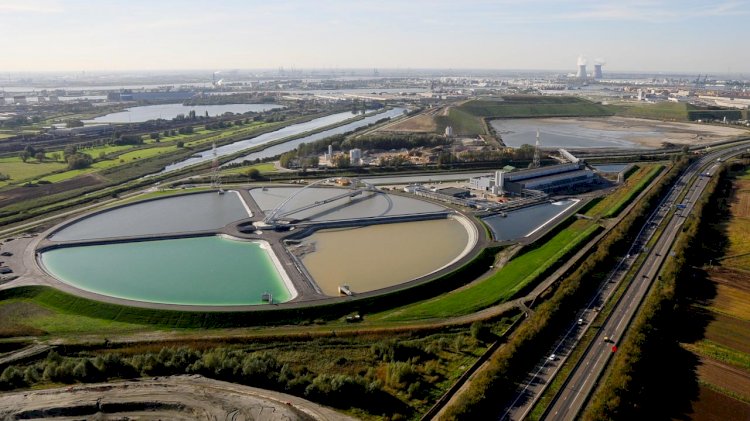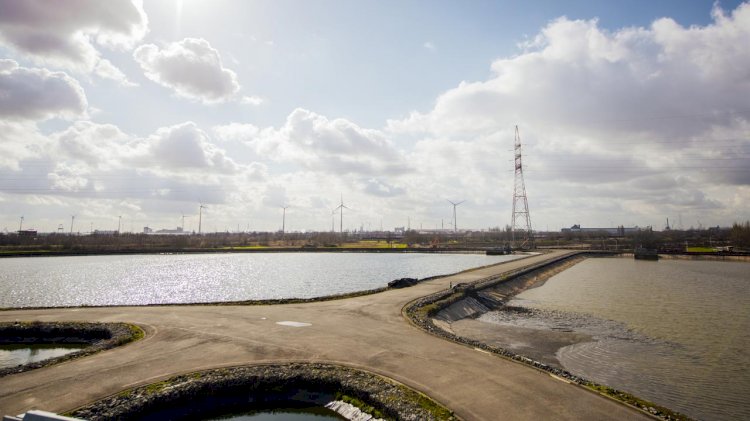The Flemish government, Port of Antwerp and contractor SeReAnt (a partnership between the Jan De Nul GROUP and DEME environmental companies) will begin dredging and processing the most polluted dredging sludge at the port, the so-called TBT sludge, this month.
Lydia Peeters, Flemish Minister of Mobility and Public Works, says:
“After years of research, there is now finally a solution to this historical pollution. This is a worldwide first and a milestone for Flanders and Port of Antwerp. We will remove the most contaminated sludge from the docks. As a result, water quality will improve substantially.”
The Flemish government and Port of Antwerp are keeping the docks of the port of Antwerp accessible for contemporary shipping together. Every year, enormous quantities of sludge are dredged for this purpose and then processed by the AMORAS dewatering installation.
Yi-Bin Shan, Head of the Maritime Access Department at the Department of Mobility and Public Works, says:
“But there was one type of sludge we couldn’t process yet: sludge with elevated organotin concentrations or Tributyltin, or TBT sludge for short. TBT had been used worldwide in ship paint since the 1970s to prevent the growth of mussels and algae on hulls, but has been completely banned since 2003. After all, the product is enormously harmful to the environment and is also difficult to break down. The sludge has been storing TBT like a sponge all these years and is gradually releasing this contamination. This is disrupting the metabolism and hormone action of molluscs in particular, such as snails and mussels.”

Jacques Vandermeiren, Port of Antwerp’s CEO, says:
“Along with the University of Antwerp, we have been investigating for several years how to get TBT out of the port. We are proud that we can finally tackle this historical pollution. Currently, the water quality in the docks scores below the European standard. This project will greatly improve it. As a port authority, we believe it’s important to take responsibility in respect of society. This makes us the only port in the world that not only removes polluted sludge, but also processes it sustainably.”
The Flemish government and Port of Antwerp are jointly releasing the necessary resources for dredging and processing the most polluted dredging sludge.
Flemish Minister Lydia Peeters says:
“Flanders makes 25 million euros available annually for the operation of AMORAS. We are now making an additional investment of 700,000 euros a year to dispose of TBT spoil in an ecologically responsible manner. This way, we can increase the accessibility of the port, an important task for the Flemish government. Port of Antwerp has invested 1 million euros in the preliminary phase of this project and will release 1.5 million euros a year for the effective processing of TBT spoil,” port alderman Annick De Ridder continues. “Port of Antwerp wants to be an inspiration for other ports and take a pioneering role in the field of sustainability”.

Processing the total quantity of polluted sludge at the port of Antwerp is a long-term task. A pilot project was started in 2018 after obtaining the necessary permits and some modifications to the water treatment plant.
Yi-Bin Shan, Head of Maritime Access, says:
“We have added an extra step to our processes and installed activated carbon filters. These filter the toxic substances out of the water after it passes through our treatment plant. During that pilot project, we had already dredged, transferred and processed 185,000 m³ of heavily contaminated sludge on AMORAS. In this way, we were able to properly map out the impact on the installation and all possible risks. Now, there is an agreement to remove 800,000 m³ of sludge from the harbour docks over the next five years and process it into 500,000 tonnes of filter cake. We’ll first remove the sludge that obstructs nautical access and the worst TBT hotspots in the older, southern part of the port. Then we’ll deal with the other areas.”
How will this work?
- The contaminated TBT spoil is dredged at the port. With a 15 m³ environmental grab, the spread of pollution in the surrounding water is avoided.
- The dredging sludge is transported in 2,400 m³ transport containers to the AMORAS processing plant.
- SeReAnt, the contractor operating the AMORAS plant, extracts the sludge from the transport containers and pumps it into the treatment plant.
- Coarse dirt and sand are removed.
- The waste water is purified via a water treatment plant. TBT sludge is also purified by activated carbon. Then the water flows back into the docks.
- The sludge is processed into a dry end product: filter cakes that are safely stored on site.
AMORAS: innovative cooperation between government, port and dredging companies
Through AMORAS, the Flemish government and Port of Antwerp are working together on the sustainable and long-term storage and processing of maintenance dredging sludge from the Antwerp docks. AMORAS stands for Antwerp Mechanical Dewatering, Recycling and Application of Sludge. The Department of Mobility and Public Works provides 80% of the funds, while Port of Antwerp provides the other 20%. Since 2011, the dewatering plant has been processing 450,000 tonnes of dry matter into filter cakes every year. The temporary trade association SeReAnt operates the installation.
SeReAnt is a collaboration between the environmental companies DEC of Deme Group and Envisan of Jan De Nul Group. AMORAS is constantly looking for solutions for re-using the dry matter obtained from non-polluted dewatered sludge in useful applications. There are several routes, but the concrete industry in particular is showing interest in the filter cakes.



